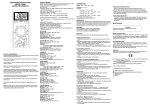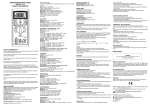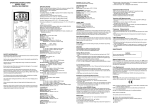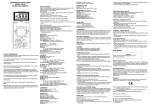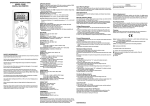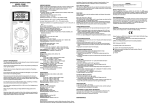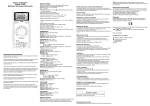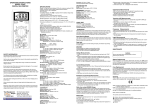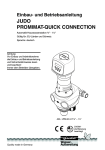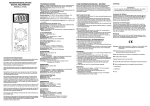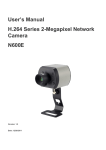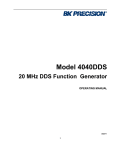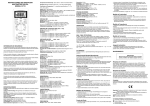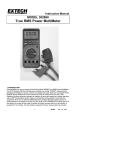Download OPERATING INSTRUCTIONS MODEL 2703C DIGITAL MULTIMETER
Transcript
OPERATING INSTRUCTIONS MODEL 2703C DIGITAL MULTIMETER SPECIFICATIONS Display: 3½ digit liquid crystal display (LCD) with a maximum reading of 1999. Polarity: Automatic, positive implied, negative polarity indication. Overrange: (OL) or (-OL) is displayed. Zero: Automatic. Low battery indication: The " " is displayed when the battery voltage drops below the operating level. Measurement rate: 2.5 times per second, nominal. Auto power off: Approx. 25 minutes. Operating environment: 0℃to 50℃at < 70% relative humidity. Storage temperature: -20℃to 60℃, 0 to 80% relative humidity. Accuracy: Stated accuracy at 23 ℃±5℃, < 75% relative humidity. Temperature Coefficient: 0.1 x (specified accuracy) per ℃. (℃to 18℃, 28℃ to 2703C V V 50℃). Altitude: 6561.7 feet (2000m). Power: Single standard 9-volt battery, NEDA 1604, JIS 006P, IEC 6F22. Battery life: 200 hours typical with carbon-zinc. Dimensions: 165mm (H) x78mm (W) x42.5mm (D). Weight: Approx. 10.0 oz.(285g) including holster. Accessories: One set test leads, one spare fuse, 9V battery (installed), and Operating Instructions. DC VOLTS Ranges: 2V, 20V, 200V, 1000V Resolution: 1mV Accuracy: ± ( 1.2% rdg + 1 dgt) Input impedance: 10MΩ Overload protection: 1000VDC or 750VAC rms A AC VOLTS BATT 1.5V mA COM V 10A (50Hz - 500Hz) Ranges:200V, 750V Resolution: 0.1V Accuracy: ± ( 2.0% rdg + 5 dgts) on 200V range ± ( 2.0% rdg + 10 dgts) on 750V range Input impedance: 10MΩ Overload protection: 1000VDC or 750VAC rms DC CURRENT SAFETY INFORMATION The following safety information must be observed to ensure maximum personal safety during the operation at this meter: Use the meter only as specified in this manual or the protection provided by the meter might be impaired. Ranges: 2mA, 20mA, 200mA, 10A Resolution: 1uA Accuracy: ± (1.5% rdg + 1 dgts) on 2mA to 200mA ranges ± (3.0% rdg + 3 dgts) on 10A range Input protection: 0.5A/500V fast blow ceramic fuse on mA input 10A/600V fast blow ceramic fuse on mA input 10A input:10A for 60 seconds maximum followed by a 10 minutes cooling period. RESISTANCE Test the meter on a known voltage before using it to determine if hazardous voltage is present. Do not use the meter if the meter or test leads look damaged, or if you suspect that the meter is not operating properly. Never ground yourself when taking electrical measurements. Do not touch exposed metal pipes, outlets, fixtures, etc., which might be at ground potential. Keep your body isolated from ground by using dry clothing, rubber shoes, rubber mats, or any approved insulating material. Turn off power to the circuit under test before cutting, unsoldering, or breaking the circuit. Small amounts of current can be dangerous. Use caution when working above 60V dc or 30V ac rms. Such voltages pose a shock hazard. When Using the probes, keep your fingers behind the finger guards on the probes. Measuring voltage which exceeds the limits of the multimeter may damage the meter and expose the operator to a shock hazard. Always recognize the meter voltage limits as stated on the front of the meter. Ranges: 200Ω, 2k, 20k, 200k, 20MΩ Resolution: 0.1Ω Accuracy: ± (1.5% rdg + 4 dgts) on 200 Ωto 200kΩranges ± (3.0% rdg + 5 dgts) on 20MΩrange Open circuit volts: 0.3Vdc typical, (3.0Vdc on 200Ωrange) Overload protection: 500VDC or AC rms CONTINUITY Audible indication: Less than 100Ω Response time: 100ms Overload protection: 500VDC or AC rms DIODE TEST Test current: Approx. 1.0mA Accuracy: ±(3.0% rdg + 3dgts) Open circuit volts: 3.0Vdc typical Overload protection: 500VDC or AC rms BATTERY TEST Ranges: 1.5V, 9V Resolution: 1mV, 10mV Accuracy: ±(3.5% rdg + 2 dgts) Loaded current:150mA typical for 1.5V range, 5mA typical for 9V range Overload protection: 500V DC or AC rms on 9V range, 0.5A/500V fast blow ceramic fuse on 1.5V range. OPERATION Fuse Replacement Before taking any measurements, read the Safety Information Section. Always examine the instrument for damage, contamination (excessive dirt, grease, etc.) and defects. Examine the test leads for cracked or frayed insulation. If any abnormal conditions exist do not attempt to make any measurements. If no current measurements are possible. check for a blown overload protection fuse. For access to fuses, remove the three screws from the back of the meter and lift off the front case. Replace F1 only with the original type 0.5A/500V, fast acting ceramic fuse, 6.35x32mm . Replace F2 only with the original type 10A/600V, fast acting ceramic fuse, 6.35x25.4mm. Voltage Measurements 1.Connect the red test lead to ”VΩ” jack and the black test lead to the ”COM” jack. 2.Set the Function/Range switch to the desired voltage type (AC or DC) and range. If magnitude of voltage is not known, set switch to the highest range and reduce until a satisfactory reading is obtained. 3.Connect the test leads to the device or circuit being measured. 4. For dc, a (-) sign is displayed for negative polarity; positive polarity is implied. Current Measurements Cleaning Wipe the case with a damp cloth and mild detergent. Do not use abrosives or solvents. Dirt or moisture in the terminals can affect readings. 1.Connect the red test lead to the (uA, mA or 10A) jack and the black test lead to the "COM" jack. 2.Set the Function/Range switch to the DC or AC ranges. 3.Remove power from the circuit under test and open the normal circuit path where the measurement is to be taken. Connect the meter in series with the circuit. 4.Apply power and read the value from the display. Safety: Conforms to IEC61010-1 (EN61010-1), CATII 1000V, CATIII 600V, Class II, Pollution degree 2 Indoor use. CATII: Is for measurements performed on circuits directly connected to the low-voltage installation. CAT III: Is for measurements performed in the building installation. Resistance and Continuity Measurements The symbols used on this instrument are: 1.Set the Function/Range switch to the desired resistance range or continuity position. 2.Remove power from the equipment under test. 3.Connect the red test lead to the “ VΩ” jack and the black test lead to the ”C O M ” jack. 4.Touch the probes to the test points. In ohms, the value indicated in the display is the measured value of resistance. In continuity test, the beeper sounds continuously, if the resistance is less than 100Ω. Diode Tests 1.Connect the red test lead to the “ VΩ” jack and the black test lead to the ”C O M ” jack. 2.Set the Function/Range switch to the “ “ position. 3.Turn off power to the circuit under test. External voltage across the components causes invalid readings. 4.Touch probes to the diode. A forward-voltage drop is about 0.6V (typical for a silicon diode). 5.Reverse probes. If the diode is good, “OL” is displayed. If the diode is shorted, “000” or another number is displayed. 6. If the diode is open, “OL” is displayed in both directions. Battery Test 1. Connect the red test lead to the (mA/BATT 1.5V) jack and the black test lead to the "COM" jack. 2. Set the Function/Range switch to the desired 1.5V battery test range. 3. Connect the test leads to the 1.5Vdc battery under test. Normally, a good 1.5Vdc battery will read above 1.25Vdc. Consult the battery manufacturer for complete battery specifications to determine actual battery life remaining and condition of battery. MAINTENANCE WARNING Remove test leads before changing battery or fuse or performing any servicing. Battery Replacement Power is supplied by a 9 volt battery. (NEDA 1604, IEC 6F22). The " " appears on the LCD display when replacement is needed. To replace the battery, remove the three screws from the back of the meter and lift off the front case. Remove the battery from case bottom. EMC: Conforms to EN61326. Caution, refer to accompanying documents Equipment protected throughout by Double insulation (Class II) Alternating current Direct current Ground INSTRUCCIONES DE FUNCIONAMIENTO MODELO 2703C MULTIMETRO DIGITAL VOLTIOS de CD Rangos: 2V, 20V, 200V, 1000V Resolución : 1mV Precisión: ± (0.5% lectura + 1dgt) Impedancia de entrada: 10MΩ Protección de sobrecarga:1000VCD o 750VCA rms 2703C V V A BATT 1.5V mA COM Entorno operativo: 0° a 50° a <70% de humedad relativa. Temperatura de almacenamiento: -20° a 60°, de 0 a 80% de humedad relativa. Precisión: Dicho de precisión a 23° ± 5°, <75% de humedad relativa. Coeficiente de temperatura: 0.1 x (exactitud especificada) por °C. (°C a 18°C, 28°C a 50°C). Altitud: 6561,7 pies (2000m). Potencia: El único estándar de la batería de 9 voltios, NEDA 1604, JIS 006P, IEC 6F22. La duración de la batería: 200 horas típico con carbono-zinc. Dimensiones: 165mm (H) x78mm (W) x42.5mm (D). Peso: aprox. 10,0 oz (285g) incluyendo funda. Accesorios: Un conjunto conductores de prueba, un fusible de repuesto, batería de 9V (instalada), y Manual de instrucciones. V 10A INFORMACION DE SEGURIDAD La siguiente información relativa a la seguridad deben ser observadas para garantizar la máxima seguridad personal durante la operación de este metro: Utilice el medidor sólo como se especifica en este manual o la protección prevista en el metro podría verse afectada. Pruebe de que el medidor en un voltaje conocido antes de usarlo para determinar si está presente la tensión peligrosos. No utilice el medidor si el medidor o los conductores de prueba parecen dañados, o si sospecha que el medidor no está funcionando correctamente. Nunca esté conectado a tierra cuando este tomando mediciones eléctricas. No toque las tuberías de metal expuesto, puntos de venta, accesorios, etc, que podrán estar conectados a tierra. Mantenga su cuerpo aislados de tierra mediante el uso de ropa seca, zapatos de goma, alfombras de caucho, o cualquier material aislante aprobado. Apague la potencia al circuito bajo prueba antes de cortar, quitar soldadura, o romper el circuito. Pequeñas cantidades de corriente pueden ser peligrosas. Tenga cuidado cuando se trabaja con mas de 60V de CD o 30 V CA rms. Esas tensiones plantean un peligro de choque. Al utilizar las sondas, mantenga los dedos detrás del dedo de la mano de los guardias de las sondas. La medición de tensión que excede los límites del multímetro puede dañar el medidor y el operador se puede de exponer a un peligro de choque. Siempre reconozca los límites de voltaje en el frente del medidor. ESPECIFICACIONES Pantalla: 3 ½ dígitos, pantalla de cristal líquido (LCD) con un máximo de la lectura de 1999. Polaridad: Automática, positiva implícita, indicación de polaridad negativa. Sobre Rango: (OC) o (-OC) aparece en pantalla. Cero: Automático. Indicación de batería baja: El " " aparece cuando el voltaje de la batería cae por debajo del nivel de funcionamiento. Tipo de Medición: 2,5 veces por segundo, nominal. Apagado automático: aprox. 25 minutos. VOLTIOS de AC (50Hz - 500Hz) Rangos: 200V, 750V Resolución : 0.1V Precisión: ± (2.0% lectura +5dgts) Impedancia de entrada: 10MΩ Protección de sobrecarga: 1000VDC o 750VAC rms CORRIENTE Rangos: 2mA, 20mA, 200mA, 10A Resolución : 1uA Precisión CD: ± (1.5%rdg + 1dgts) en 2mA a 200mA ± (3.0%rdg + 3dgts) en 10A range Entrada de protección: 0.5A/500V fusibles rápido de cerámica 10A/600V fusibles rápido de cerámica Entrada de 10A: 10A máximo durante 60 segundos seguidos Por 10 minutos en un período de enfriamiento RESISTENCIA Rangos: 200Ω, 2kΩ, 200kΩ, 20MΩ Resolución : 0.1Ω Precisión: ± (1.0% lectura + 4dgts) sobre 200Ωa 200kΩrangos ± (2.0% lectura + 5dgts) en la gama 20MΩ Voltios de circuito abierto: 0.3Vdc (3.0Vdc gama de 200Ω) Protección de sobrecarga: 500VCD o CA rms CONTINUIDAD Indicación audible: Menos de 100Ω Tiempo de respuesta: 100ms Protección de sobrecarga: 500VCD o CA rms PRUEBA DE DIODO Corriente de prueba: aprox. 1.0mA Precisión: ± (1,5% lectura + 3dgts) Voltios circuito abierto: 3.0Vdc típico Protección de sobrecarga: 500VCD o CA rms 4. Para muestra polaridad negativa, un (-) se demuestra; polaridad positiva es implicado. Las mediciones de Corriente 1.Conecte el conductor rojo de prueba a la (tC, mA o 10A) jack y el conductor negro de prueba a la "COM" jack. 2. Seleccione la Función / Rango para cambiar de los rangos de CD a CA. 3. Elimine el poder del circuito bajo prueba y abra el circuito normal de ruta donde la medición es que se deben tomar. Conecte el medidor en serie con el circuito. 4. Aplicar y poder leer el valor de la exhibición. Mediciones de Resistencia y Continuidad 1. Seleccione la Función / Rango cambiar a la resistencia deseada gama. 2. Elimine el poder de los equipos bajo prueba. 3. Conecte el conductor rojo de prueba a la "V Ω" jack y el conductor negro de prueba a la "COM" jack. 4. Toque las sondas a los puntos de prueba. En ohmios, el valor indicado en la pantalla es el valor medido de la resistencia. En la continuidad de prueba, el zumbador suena continuamente, si la resistencia es inferior a 100Ω. Pruebas de Diodo 1.Conecte el conductor rojo de prueba a la "V Ω" jack y el conductor negro de prueba a la "COM" jack. 2. Seleccione la Función / Rango a al posición de "(diode symbol)". 3. Elimine el poder de los equipos bajo prueba. Exteriores voltaje a través de los componentes causas lecturas no válidas. 4. Toque las sondas al diodo. Una caída de tensión hacia adelante-es de unos 0.6V (típico para un diodo de silicio). 5. Reverse sondas. Si el diodo es bueno, el "OL" se muestra. Si el diodo está e n cortocircuito, "000" u otro número aparece en la pantalla. 6. Si el diodo está abierto, el "OL" se muestra en ambas direcciones. 7. Indicación audible: Menos de 0.03V. Prueba de Batería 1. Conecte el conductor de prueba rojo a el (mA / BATT 1.5V) jack y el conductor negro de prueba a el "COM" jack. 2. Establezca la Función / Rango por cambiando a la deseada gama de 1.5V. 3. Conecte los conductores de prueba a la batería de 1.5Vcd bajo prueba. Normalmente, una buena batería de 1.5Vcd dará lectura sobre 1.25Vcd. Consulte fabricante de la batería para determinar las especificaciones reales de la vida de la batería restante y el estado de la batería. MANTENIMIENTO ADVERTENCIA Eliminar conductores de prueba antes de cambiar la batería o fusible o realización de cualquier servicio. Reemplazo de baterías La potencia es suministrada por una batería de 9 voltios. (NEDA 1604, IEC 6F22). El "(battery symbol)" aparece en pantalla, cuando el reemplazo es necesario. Para sustituir la batería, quite los tres tornillos de la parte posterior del medidor y el ascensor frente a la parte delantera caso. Extraiga la batería caso de la parte inferior. Prueba de Bateria Rango: 1.5V, 9V Resolución : 1mV, 10mV Precisión: ± 3.5%rdg + 2dgts) Carga de corriente: 150mA típico de 1.5V gama, 5mA Gama típica de 9V Protección de sobrecarga: 500VCD o CA rms gama de 9V, 0.5A/500V fusible rápido de cerámica de 1.5V gama. OPERACIÓN Antes de tomar cualquier medida, lea la sección de Información sobre Seguridad. Siempre examine el instrumento para para daños, la contaminación (exceso de suciedad, grasa, etc) y defectos. Examine los conductores de prueba para agrietados o rotos aislamiento. Si alguna de la condiciones existe no intente realizar las mediciones. Luz de Fondo Oprime el botón para activar la luz de fondo por aproximadamente 60 segundos. Las mediciones de voltaje 1.Conect e el conductor rojo de prueba a la "V Ω" jack y el conductor negro de prueba a la "COM" jack. 2. Seleccione la Función / Rango de cambio al tipo deseado de voltaje (CA o CD) y la variedad. Si la magnitud de la tensión no es conocida, sistemáticamente camb ie a una escala mayor y reduzca el rango a una manera satisfactoria hasta que se obtenga la lectura adecuada. 3. Conecte los conductores de prueba al dispositivo o circuito con que se mide. Reemplazo de fusibles Si las mediciones de corriente no son posibles. Revise por el fusible de protección de sobrecarga que no este quemado. Para el acceso a los fusibles, quite los tres tornillos de la parte posterior del medidor y el ascensor frente a la parte delantera caso. Sustituir F1 sólo con el tipo original 0.5A/500V, actuando rápida de fusibles de cerámica, 6.35x32mm Sustitúyase F2 sólo con el original 10A/600V tipo, que actúan rápido de fusibles de cerámica, 6.35x25.4mm. Limpieza Limpie el caso con un paño húmedo y detergente suave. No utilice productos abrasivos o disolventes. La humedad o la suciedad en los terminales pueden afectar a las lecturas. Seguridad: Se ajusta a IEC61010 -1 (EN61010-1), CATII 1000V, CATIII 600 V, clase II, grado de contaminación 2 Salas de uso. CATII: Es para las mediciones realizadas en los circuitos conectados directamente a la instalación de baja tensión CAT III: Es para las mediciones realizadas en la construcción de la instalación. EMC: Se ajusta a EN61326. The symbols used on this instrument are: Precaución, refiérase a los documentos que la acompañan Equipo protegido en todo momento por doble aislamiento (clase II) Corriente alterna Corriente Ground Manuel d’utilisation Modèle 2703C Multimètre Numérique 2000 points SPECIFICATIONS Affichage: 3½ digit (LCD) avec un affichage de 1999 maximum Polarité: Automatique, avec indication du signe moins. Dépassement: (OL) ou (-OL) est affiché. Zéro: Automatique. Indication de pile usée: le symbole " "est affiché lorsque la pile est usée et qu’il faut la remplacée. Cadence de mesure: 2.5 fois/s (typique) Arrêt automatique: après environ 25 minutes. Température de fonctionnement: 0℃ à 50℃ avec HR < 70%. Température de stockage: -20℃ à 60℃, HR de 0 à 80%. Précision: donnée à 23℃ ±5℃, HR < 75%. Coefficient de température: 0.1 x (précision) par ℃. (℃ < 18℃, et de 28℃ à 2703C V V 50℃). Altitude: utilisation jusqu’à 2000m. Alimentation: pile 9 V t ype NEDA 1604, JIS 006P, IEC 6F22. Autonomie: 200 heures typique. Dimensions: 165mm (H) x 78mm (W) x 42.5mm (D). Masse: environ 285g avec gaine Accessoires: jeu de cordons, fusible de rechange, pile (9V) installée, manuel. Remplacement des fusibles MISE EN OEUVRE Avant toute mesure, assurez-vous d’avoir pris connaissance des Prescriptions de Sécurité. Toujours vérifier que l’appareil et ses cordons ne sont pas endommagés. Si vous avez le moindre doute, ne pas effectuer de mesure. Mesures de tension 1. Brancher le cordon rouge à la borne ”VΩ” et le cordon noir à la borne ”COM”. 2. Positionner le commutateur sur la gamme appropriée en DC ou AC. Toujours commencer par la gamme la plus élevée si vous ne connaissez pas la valeur à mesurer. 3. Brancher les cordons sur votre application. 4. Lire le résultat sur l’afficheur LCD. La polarité est indiquée avec le signe (-) en DC A TENSIONS AC (50Hz - 500Hz) BATT 1.5V mA COM V 10A Gammes: 200V, 750V Résolution: 0.1V Précision: ± ( 2.0% + 5 dgts) sur 200V ± ( 2.0% rdg + 10 dgts) sur 750V Impédance d’entrée: 10MΩ Protection: 1000VDC ou 750VAC eff. COURANTS DC PRESCRIPTIONS DE SECURITE Les prescriptions de sécurité ci dessous sont à suivre scrupuleusement afin de garantir la sécurité de l’utilisateur: N’utiliser votre appareil que dans le domaine d’utilisation défini dans ce manuel. Dans le cas contraire les protections pourraient être endommagées. Toujours tester votre appareil sur une tension connue avant de l’utiliser pour une mesure de tension. Ne pas utiliser votre appareil o uses cordons vous semblent endommagés. Ne jamais vous mettre à la terre lorsque vous faites des mesures de tension. Ne jamais toucher des parties métalliques qui pourraient être reliées à la terre lors d’une mesure. Dans la mesure du possible, isolez-vous de la terre par des chaussures, vêtements ou gants appropriés. Pensez à couper le courant avant d’ouvrir un circuit ou d’intervenir sur celui-ci. Même un faible potentiel peut être dangereux. Prenez toutes les précautions nécessaires lorsque vous intervenez sur des tensions supérieures à 60V DC ou 30V AC eff. Lorsque vous utilisez des pointes de touche, ne jamais mettre les doigts au delà des anneaux de garde. Mesurer des tensions ou grandeurs au delà des limites de l’appareil peut endommager les protections, endommager votre appareil et mettre en danger la sécurité de l’utilisateur. Assurez vous de connaître les limites de votre appareil, avant utilisation. Gammes: 2mA, 20mA, 200mA, 10A Résolution: 1uA Précision: ± (1.5% + 1 dgts) sur 2mA et 200mA ± (3.0% + 3 dgts) sur la gamme 10A Protection: fusible rapide0.5A/500V sur les gammes mA Fusible rapide 10A/600V sur la gamme 10A Entrée 10A: 10A pendant 60 secondes maximum suivi d’une période sans courant de 10minutes minimum RESISTANCE Gammes: 200Ω, 2k, 20k, 200k, 20MΩ Résolution: 0.1Ω Précision: ± (1.5% + 4 dgts) jusqu’à 200kΩ ± (3.0% + 5 dgts) sur gamme 20MΩ Tension en circuit ouvert: 0.3Vdc typique, (3.0V sur gamme 200Ω) Protection: 500VDC ou AC eff. TEST DIODE Courant de test: environ 1.0mA Précision: ±(3.0% + 3dgts) Tension en circuit ouvert: 3.0V typique Protection: 500VDC ou AC eff. TEST PILE Gammes: 1.5V, 9V Résolution: 1mV, 10mV Précision: ±(3.5% + 2 dgts) Courant de charge: 150mA typique pour la gamme1.5V, 5mA typique pour la gamme 9V Protection: 500VDC ou AC eff. Sur gamme 9V, Fusible F0.5A/500V sur gamme1.5V. Nettoyer périodiquement avec un chiffon doux et humide. Ne pas utiliser de solvants. Saleté et/ou humidité au niveau des douilles peuvent perturber les mesures et donner des indications fausses. 1. Brancher le cordon rouge à la borne (µA, mA ou 10A) et le cordon noir à la borne ”COM”. 2. Positionner le commutateur sur la gamme appropriée en DC ou AC. 3. Assurez-vous que le circuit à mesurer est hors tension et branchez vos cordons en série dans ce circuit. 4. Mettre sous tension et lire le courant sur l’afficheur LCD Sécurité: IEC61010-1 (EN61010-1), CATII 1000V, CATIII 600V, Class II, Degré de pollution 2, utilisation à l’intérieur. CATII / CAT III : se reporter aux normes pour la définition des catégories d’installation Mesures de résistance et continuité Symboles utilisés sur l’appareil: 1. Positionner le commutateur rotatif sur la gamme appropriée de résistance ou continuité. 2. Assurez-vous que le dispositif à mesurer soit hors tension. 3. Brancher le cordon rouge à la borne ”VΩ” et le cordon noir à la borne ”COM”. 4. Branchez les cordons à votre application ou tester par contact avec les pointes de touche. En test de continuité, le buzzer est actif pour R<100 ohms.. Test Diode 1. Brancher le cordon rouge à la borne ”VΩ” et le cordon noir à la borne ”COM”. 2. Positionner le commutateur sur “ “ . 3. Assurez-vous que le dispositif à mesurer soit hors tension, afin de ne pas fausser la mesure. 4. Tester la diode à l’aide des pointes de touché: le sens passant d’une diode silicium fait apparaitre une tension de 0.6V (typique) 5. Une diode ouverte ou sens bloqué se traduira par un affichage “OL”. Une diode en court-circuit se traduira par un affichage “000” ou proche de 0. 6. Remarque: une diode ouverte donne un affichage “OL” dans les 2 sens Test piles 1. Brancher le cordon rouge à la borne mA/1.5V et le cordon noir à la borne ”COM”. 2. Positionner le commutateur sur test pile 1.5V 3. Brancher les cordons aux bornes de la pile et lire la tension. Normalement une pile correcte donne une tension > 1.25V (vérifier avec votre fabricant de piles) MAINTENANCE ATTENTION - DANGER Il est impératif de débrancher les cordons avant toute opération de maintenance – Risque de choc électrique. CONTINUITE Indication sonore: pour R< 100Ω Temps de réponse: 100ms Protection: 500VDC ou AC eff. Nettoyage Mesures de courant TENSIONS DC Gammes: 2V, 20V, 200V, 1000V Résolution: 1mV Précision: ± ( 1.2% + 1 dgt) Impédance d’entrée: 10MΩ Protection: 1000VDC ou 750VAC eff. Si les mesures de courant ne fonctionnent pas, il faut vérifier l’état des fusibles qui assurent la protection de votre multimètre. Assurez-vous d’avoir débranché les cordons. Dévisser le fond de boitier et vérifier les fusibles : F1 0.5A/500V, type céramique F (rapide), 6.35x32mm. F2 10A/600V, type céramique F (rapide), 6.35x25.4mm. Attention : Ne remplacer les fusibles qu’avec le même type. Remplacement de la pile Votre multimètre utilise une pile 9V. (NEDA 1604, IEC 6F22). Lorsque le symbole " " apparait à l’affichage il faut remplacer la pile. Assurez-vous d’avoir débranché les cordons. Dévisser le fond de boitier et remplacer la pile. Revisser le fond de boitier. EMI: selon EN61326. Attention – Danger: se référer au manuel Double isolement (Classe II) Courant alternatif Courant continu Terre BEDIENUNGSANLEITUNG DIGITAL-MULTIMETER MODELL 2703C TECHNISCHE DATEN FUNKTIONSBESCHREIBUNG / BETRIEB Display: 3½ -stellige Flüssigkristallanzeige (LCD) mit max. 1999 Zählimpulsen. Polarität: Automatisch, positive Polarität implizit, negative wird angezeigt. Bereichsüberschreitung: Anzeige von (OL) oder ( -OL). Null: Automatisch Indikator bei schwacher Batteriespannung : Sinkt die Batteriespannung unter das Betriebsniveau, wird das Symbol angezeigt. Messrate: Nennwert 2,5 Mal pro Sekunde. Automatische Abschaltung: nach ca. 30 Minuten Inaktivität Betriebsumgebung: 0℃ bis 50℃ bei einer relativen Feuchtigkeit < 70%. Bevor Sie Messungen durchführen, lesen Sie bitte den Abschnitt Sicherheitsinformationen. Überprüfen Sie das Instrument stets auf Beschädigungen, Schmutz (übermäßige Verschmutzungen, Fett usw.) und Defekte. Überprüfen Sie die Isolierung der Messleitungen auf Risse oder Abnutzungserscheinungen. Das Messgerät auf keinen Fall verwenden, wenn irgendwelche ungewöhnliche Bedingungen vorliegen. Lagertemperatur: -20℃ bis 60℃, 0 bis 80% relative Feuchtigkeit. Genauigkeit: Angaben gelten für 23℃ ±5℃ und einer relativen Feuchte < 75%. Temperaturkoeffizient: 0,1 x (spezifizierte Genauigkeit) pro ℃. (℃ bis 18℃, 28 2703C V V ℃ bis 50℃). Maximale Höhenlage für den Betrieb: 2000 m. Stromversorgung: 9-Volt-Bockbatterie, Typ NEDA 1604, JIS 006P, IEC 6F22. Batterielebensdauer: 150 Stunden typisch für Kohle-Zink. Abmessungen: 165 mm (H) x 78 mm (B) x 42,5 mm (T). Gewicht: ca. 285 g inkl. Holster. Zubehör: 1 Satz Prüfkabel, 1 Stk. Ersatzsicherung, 9 V-Batterie (eingelegt) und Bedienungsanleitung. GLEICHSPANNUNG Bereiche: 2V; 20V; 200V; 1000 V. Auflösung: 1mV Genauigkeit: ± (1,2% des Messwerts + 1 Stelle) Eingangsimpedanz: 10MΩ Überlastschutz: 1000 VDC oder 750 VAC Effektivwert A mA COM V 10A SICHERHEITSINFORMATIONEN Um ein Maximum an persönlicher Sicherheit beim Betrieb dieses Multimeters zu gewährleisten, bitte unbedingt folgende Sicherheitshinweise beachten: Das Gerät nur nach der in dieser Bedienungsanleitung angegebenen Spezifikation verwenden. Ansonsten können die im Messinstrument vorhandenen Schutzmechanismen außer Kraft gesetzt sein. Testen Sie das Multimeter zuerst mit einer bekannten Spannung, bevor Sie es dafür verwenden, das Vorhandensein von gefährlichen Spannungen zu überprüfen. Das Multimeter nicht verwenden, wenn das Instrument oder die Prüfkabel Beschädigungen aufweisen oder wenn Sie den Eindruck haben, dass das Gerät nicht ordnungsgemäß funktioniert. Bei Durchführung elektrischer Messungen keine Erdung zum eigenen Körper herstellen. Niemals offen liegende, blanke Kabel, Ausgänge, Anschlüsse, Vorrichtungen, Halterungen berühren, um jeglichen Kontakt mit Erdpotential zu vermeiden. Sorgen Sie dafür, dass Ihr Körper von der Erde isoliert bleibt, indem Sie trockene Kleidung, Gummischuhe, Gummimatten oder anderes zugelassenes Isolierungsmaterial verwenden. Schalten Sie den zu prüfenden Schaltkreis zuerst stromlos, bevor Sie ihn trennen, ablöten oder unterbrechen. Auch geringe Strommengen können gefährlich sein. Seien Sie besonders vorsichtig, wenn Sie mit Spannungen arbeiten, die über 60V Gleichstrom oder 30 V Wechselstrom Effektivwert (rms) liegen. Spannungen in dieser Höhe lösen elektrische Schläge aus. Beim Umgang mit den Prüfspitzen die Finger bitte stets hinter der Abschirmung des Isoliergriffs halten. Die Messung von Spannungen, die die Grenzwerte des Multimeters übersteigen, kann das Gerät beschädigen und den Bediener der Gefahr eines Stromschlags aussetzen. Beachten Sie bitte stets die auf der Vorderseite des Geräts angegebenen Spannungsgrenzwerte. 1. Die rote Messleitung an die Buchse „VΩ” und die schwarze Messleitung an die Buchse „COM“ anschließen. 2. Den Funktions-/Bereichswahlschalter auf den gewünschten Spannungstyp (AC oder DC) und den Bereich einstellen. Ist die Größe der Spannung nicht bekannt, den Schalter auf den größten Bereich einstellen und dann reduzieren, bis ein zufriedenstellender Messwert erreicht ist. 3. Die Messleitungen an das zu messende Gerät oder den zu messenden Schaltkreis anschließen. 4. Für Gleichspannung (DC) wird für negative Polarität das Zeichen (-) angezeigt; positive Polarität ist implizit. Strommessungen 1. Die rote Messleitung an die Buchse „uA, mA oder 10A ” und die schwarze Messleitung an die Buchse „COM“ anschließen. 2. Den Funktions-/Bereichswahlschalter auf den Bereich AC oder DC einstellen. 3. Stromversorgung des zu messenden Schaltkreises abschalten und die normale Leiterbahn öffnen, an der die Messung vorgenommen werden soll. Das Multimeter mit dem Schaltkreis in Reihe schalten. 4. Den Strom einschalten und den Wert auf dem Display ablesen. Bereiche: 200V, 750V Auflösung: 0,1V Genauigkeit: ± ( 2% des Messwerts + 5 Stellen) im 200V-Bereich ± ( 2,0% des Messwerts + 10 Stellen) im 750V-Bereich Eingangsimpedanz: 10MΩ Überlastschutz: 1000 VDC oder 750 VAC Effektivwert GLEICHSTROM Diodentests Bereiche: 2mA, 20mA, 200mA, 10A Auflösung: 1µA Genauigkeit Gleichstrom: ± ( 1,5% des Messwerts + 1 Stelle) in den Bereichen 2mA bis 200mA ± ( 3,0% des Messwerts + 3 Stellen) im 10 A-Bereich Eingangsschutz: Flinke Keramiksicherung 0,5 A / 500 V Flinke Keramiksicherung 10 A / 600 V 10 A-Eingang: 10 A für 60 Sekunden Maximum gefolgt von einer Abkühlphase von 10 Minuten 1. Die rote Messleitung an die Buchse „VΩ“ und die schwarze Messleitung an die Buchse „COM“ anschließen. 2. Den Funktions-/Bereichswahlschalter auf die Position einstellen. 3. Die Stromquelle des zu messenden Schaltkreises abschalten. Externe Spannungen um die Komponenten herum führen zu fehlerhaften Messwerten. 4. Die Diode mit den Prüfspitzen berühren. Der Vorwärts-Spannungsabfall liegt bei ca. 0,6 V (typisch für eine Silikon-Diode). 5. Prüfspitzen vertauschen. Wenn die Diode in Ordnung ist, wird „OL“ angezeigt. Ist die Diode kurzgeschlossen, wird „000“ oder eine andere Zahl angezeigt. 6. Ist die Diode offen, wird „OL“ in beiden Richtungen angezeigt. WIDERSTAND Bereiche: 200Ω, 2kΩ, 200kΩ, 20MΩ Auflösung: 0,1 Ω Genauigkeit: ± ( 1,5% des Messwerts + 4 Stellen) in den Bereichen von 2kΩbis 200kΩ ± ( 3,0% des Messwerts + 5 Stellen) im 20MΩ-Bereich Leerlaufspannung: 0,3VDC ( 3 DC im Bereich 200Ω) Überlastschutz: 500 VDC oder AC Effektivwert DURCHGANGSPRÜFUNG Signalton bei: unter 100Ω. Reaktionszeit: 100ms Überlastschutz: 500 VDC oder AC Effektivwert DIODENTESTS Prüfstrom: 1,0 mA (ungefähr) Genauigkeit: ± ( 3% des Messwerts + 3 Stellen) Leerlaufspannung: 3,0VDC typisch Überlastschutz: 500 VDC oder AC Effektivwert BATTERIETEST Bereiche: 1.5V, 9V Auflösung: 1mV, 10mV Genauigkeit: ±(3.5% des Messwertes + 2 Stellen) Stromaufnahme: 150mA typisch im 1.5V Bereich, 5mA typisch im 9V Bereich Überlastschutz: 500 VDC oder AC Effektivwert im 9V Bereich, Flinke Keramiksicherung 0,5A / 500V im 1.5V Bereich. WARNHINWEIS Vor dem Austausch der Batterie oder der Sicherungen oder anderen Wartungsarbeiten bitte unbedingt die Messleitungen abstecken! Austausch der Batterie Das Gerät wird von einer 9 Volt gespeist (NEDA 1604, IEC 6F22). Wenn ein Austausch erforderlich ist, erscheint auf dem Display das Symbol . Zum Batteriewechsel entfernen Sie auf der Rückseite des Geräts die drei Schrauben und nehmen das vordere Gehäuseteil ab. Entnehmen Sie dann die Batterie aus dem Unterteil des Geräts. Austausch von Sicherungen Wenn keine Strommessungen möglich sind, überprüfen Sie, ob die Sicherungen für den Überlastschutz defekt sind. Zum Austausch der Sicherungen die drei Schrauben auf der Rückseite des Geräts entfernen und das vordere Gehäuseteil abnehmen. Die Sicherung F1 nur mit einer originalen, flinken Keramik-Sicherung des Typs 0,5 A/500 V, 6,35 x 32 mm und die Sicherung F2 nur mit einer originalen, flinken Keramik-Sicherung des Typs 10 A/600 V, 6,35 x 25,4 mm ersetzen. Reinigung Gehäuse mit einem feuchten Tuch und mildem Reiniger abwischen. Keine Scheuer- oder Lösungsmittel verwenden. Schmutz oder Feuchtigkeit an den Klemmen kann zu fehlerhaften Messergebnissen führen. Widerstandsmessungen / Durchgangsprüfung 1. Den Funktions-/Bereichswahlschalter auf den gewünschten Widerstandsbereich einstellen oder Durchgangsprüfung 2. Die Stromquelle des zu messenden Geräts abschalten. 3. Die rote Messleitung an die Buchse „V Ω“ und die schwarze Messleitung an die Buchse „COM“ anschließen. 4. Die Messleitungen an die Messpunkte anschließen und den Wert vom Display ablesen. Bei Durchgangsprüfung ertönt der Summer, wenn der Widerstand unter einem Wert von ca. 100Ωliegt WECHSELSPANNUNG (50 Hz - 500 Hz) BATT 1.5V Spannungsmessungen WARTUNG Batterietest 1. Die rote Messleitung an die Buchse (mA/BATT 1.5V und die schwarze Messleitung an die Buchse „COM“ anschließen. 2. Den Funktions-/Bereichswahlschalter auf die gewünschte 1,5V Batterietestspannung einstellen. 3. Die Messleitungen an die Batterie anschließen. Eine gute 1,5Vdc Batterie sollte einen Messwert über 1,25Vdc anzeigen. Sicherheit: Erfüllt die Normen IEC61010-1 (EN61010-1), CATII 1000V, CATIII 600V, Klasse II, Verschmutzungsgrad 2 zur Verwendung in Innenräumen. CATII: Gilt für Messungen an Schaltkreisen, die direkt mit eine Niederspannungseinrichtung verbunden sind. CAT III: Gilt für Messungen an Geräten in Festinstallationen in Gebäuden. EMV: Erfüllt die Norm EN61326. Folgende Symbole finden Sie auf dem Gerät: Vorsicht! Bitte Sicherheitshinweise in beiliegenden Dokumenten beachten. Gerät durchgängig geschützt durch doppelte Isolierung (Klasse II) Wechselstrom Gleichstrom Erde Limited One-Year Warranty B&K Precision warrants to the original purchaser that its products and the component parts thereof, will be free from defects in workmanship and materials for a period of one year from date of purchase from an authorized B&K Precision distributor. B&K Precision will, without charge, repair or replace, at its option, defective product or component parts. Returned product must be accompanied by proof of the purchase date in the form of a sales receipt. To obtain warranty coverage in the U.S.A., this product must be registered by completing the warranty registration form on www.bkprecision.com within fifteen (15) days of purchase. Exclusions: This warranty does not apply in the event of misuse or abuse of the product or as a result of unauthorized alterations or repairs. The warranty is void if the serial number is altered, defaced or removed. B&K Precision shall not be liable for any consequential damages, including without limitation damages resulting from loss of use. Some states do not allow limitations of incidental or consequential damages. So the above limitation or exclusion may not apply to you. This warranty gives you specific rights and you may have other rights, which vary from state-tostate. SERVICE INFORMATION Warranty Service: Please go to our website, www.bkpreicsion.com & click on the service/repair button to obtain an RMA #. Return the product in the original packaging with proof of purchase to the address below. Clearly state in writing the performance problem and return any leads, probes, connectors and accessories that you are using with the device. Non-Warranty Service: Please go to our website, www.bkpreicsion.com & click on the service/repair button to obtain an RMA #. Return the product in the original packaging to the address below. Clearly state in writing the performance problem and return any leads, probes, connectors and accessories that you are using with the device. Customers not on open account must include payment in the form of a money order or credit card. For the most current repair charges please visit www.bkprecision.com and click on “service/repair”. Return all merchandise to B&K Precision Corp. with pre-paid shipping. The flat-rate repair charge for Non-Warranty Service does not include return shipping. Return shipping to locations in North American is included for Warranty Service. For overnight shipments and non-North American shipping fees please contact B&K Precision Corp. B&K Precision Corp. 22820 Savi Ranch Parkway Yorba Linda, CA 92887 www.bkprecision.com 714-921-9095 Include with the returned instrument your complete return shipping address, contact name, phone number and description of problem.






